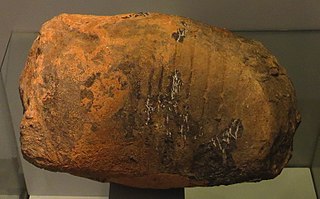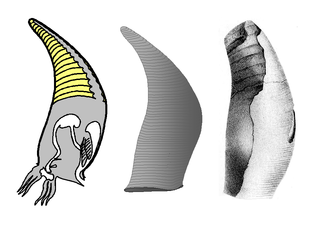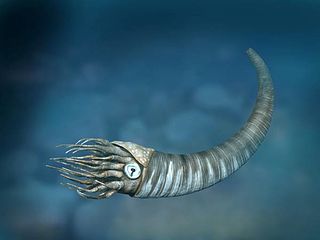
Nautiloids are a group of marine cephalopods (Mollusca) which originated in the Late Cambrian and are represented today by the living Nautilus and Allonautilus. Fossil nautiloids are diverse and species rich, with over 2,500 recorded species. They flourished during the early Paleozoic era, when they constituted the main predatory animals. Early in their evolution, nautiloids developed an extraordinary diversity of shell shapes, including coiled morphologies and giant straight-shelled forms (orthocones). No orthoconic and only a handful of coiled species, the nautiluses, survive to the present day.

Septa are thin walls or partitions between the internal chambers (camerae) of the shell of a cephalopod, namely nautiloids or ammonoids.

The Tarphycerida were the first of the coiled cephalopods, found in marine sediments from the Lower Ordovician to the Middle Devonian. Some, such as Aphetoceras and Estonioceras, are loosely coiled and gyroconic; others, such as Campbelloceras, Tarphyceras, and Trocholites, are tightly coiled, but evolute with all whorls showing. The body chamber of tarphycerids is typically long and tubular, as much as half the length of the containing whorl in most, greater than in the Silurian Ophidioceratidae. The Tarphycerida evolved from the elongated, compressed, exogastric Bassleroceratidae, probably Bassleroceras, around the end of the Gasconadian through forms like Aphetoceras. Close coiling developed rather quickly, and both gyroconic and evolute forms are found in the early middle Canadian.
Osbornoceras is a genus of Lower Silurian cyrtoconic nautiloid cephalopods known from Ohio and possibly Manitoba, one of five general currently included in the oncocerid family Karoceratidae.
Brevicoceras is an extinct nautiloid genus from the order Oncocerida with wide distribution in the Middle Devonian in Eastern North America, Russia and Morocco. Nautiloids form a broad group of shelled cephalopods that were once diverse and numerous but are now represented by only a handful of species in two genera.
Streptoceras is a genus in the extinct oncocerid family Acleistoceratidae that plied the shallow sea floor from the Middle Silurian to the Middle Devonian. Streptoceras is characterized by a shell that is large but short in proportion (breviconic) with the ventral profile convex and dorsal profile concave in the posterior part, convex over the body chamber, then concave toward the front, like Amphycertoceras, but with a triangular shaped aperture. Streptoceras is found in the Middle Silurian of North America, in Ontario.
Acleistoceras is a genus of the oncocerid, nautiloid family Acleistoceratidae that lived in the shallow seas that covered much of North America during the Devonian; living from 409—383.7 mya, existing for approximately 25.3 million years.
The Graciloceratidae is a family of nautiloid cephalopods from the Middle and Upper Ordovician belonging to the Oncocerida, characterized by exogastric cyrtocones that expand slightly or moderately and have thin walled, orthochoanitic marginal or subventral, tubular siphuncles.
Conostichoceras is a genus of exogastric, breviconic oncocerids included in the family Nothoceratidae, known from the Middle Devonian of central Europe and Upper Devonian of Australia. It probably lived on and swum above the sea floor.
Blakeoceras is a nautiloid cephalopod from the Oncocerida family Nothoceratidae with a curved shell that lived in shallow seas from the Silurian to the Middle Devonian in what has become Europe.
Actinomorpha is a genus of valcouroceratid, order Oncocerida, from the Middle Ordovician of central North America, named by Rousseau Flower, 1943. The shell is breviconic, short and laterally compressed; the venter more narrowly rounded than the dorsum, having the effect of a modest keel in horizontal orientation. The shell is gibbous adorally, such that the body chamber is widest well behind the aperture. The siphuncle is ventral, which could also be indicative of a horizontal orientation in life, with broad, slightly inflated segments and continuous, radial, actinosiphonate, deposits.
Valcouroceras is the type genus for the Valcouroceratidae, a family in the nautiloid order Oncocerida named by Rousseau Flower, 1943, named for Valcour Island in Lake Champlain, between New York state and Vermont, where it was first discovered.
Grimsbyoceras is a nautiloid genus included in the Oncocerida order of the family Acleistoceratidae that lived during the Middle Devonian. They have been found in North America (Illinois) and central Europe.

Gomphoceras is a questionable nautiloid cephalopod genus assigned to the Oncocerida. The family to which it might belong is undetermined.
Leonardoceras is a genus of nautiloid cephalopods from the lower Middle Ordovician of Nevada (USA), the shell a small slender exogastric cyrtocone with the venter more narrowly rounded than the dorsum, resembling in overall form a small Bassleroceras. Septa are close spaced, the living chamber short, the siphuncle close to the venter.
Tetrameroceras is a genus of short, essentially straight, breviconic, nautiloid cephalopods from the middle and Upper Silurian of Europe and North America included in the oncocerid family Hemiphragmoceraidae.
Aletoceras is a genus of Oncocerida nautiloids from the middle Devonian of North America included in the family Brevicoceratidae.

Mecynoceras is a genus of Late Devonian oncocerids included in the Poterioceratidae, a family of subcircular to compressed exogastric cyrtocones without a hyponomic sinus.

Oncoceras is a genus of oncocerids, family Oncoceratidae from the middle and upper Ordovician of North America and Europe.

Multiceratoidea is a major subclass or superorder of Paleozoic nautiloid cephalopods. Members of this group can be characterized by nautilosiphonate connecting rings, with an organic inner layer and outer layer of calcitic spherules and blades, similar to the modern nautilus. The earliest-diverging multiceratoids have oncomyarian muscle scars, though several orders trend towards a ventromyarian condition. Multiceratoid shells are generally short and curled, with a relatively small aperture (opening). Cameral deposits are never found among the multiceratoids, though several orders are known to bear endosiphuncular deposits within their siphuncles.






